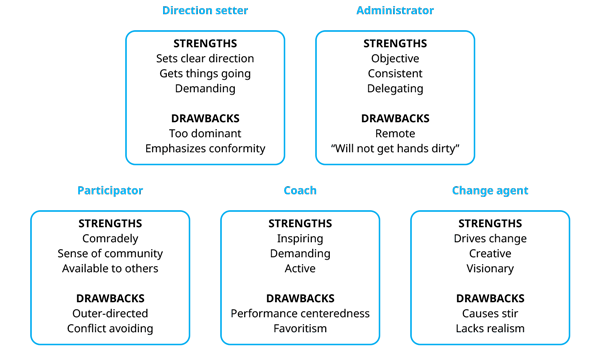< Lessons

The following division of leadership behavior underscores a realistic view according to which there is no single superior way to lead other people. All the five presented roles represent equally competent, "good" ways to lead others. The competence value of each role depends on the given context where leadership is practiced. All roles are imperfect, each contains weaknesses or potential drawbacks in addition to clear strengths. Neither are people perfect but craggy and fallible. Examination of leadership roles leads everyone to get their "feet wet", to face personal development needs in leadership. The figure below helps in identifying one's preferred roles. A particular self-appraisal form can be used for rank ordering the roles. Print the PDF form.

The Direction setter simply sets direction to others. He/she is strong-willed, walks IN FRONT of the team and is at his/her best as a leader of an organization or team that functions in a predictable, norm compliant manner. The role's potential drawbacks are in being overly dominant and suppressing all "non-fitting" or creative behavior.
The Administrator "administers" things and people. He/she delegates things and walks in the team's BACKGROUND and is at best as a leader of independent professionals. The role's potential drawbacks are in being too remote, unwilling to get his/her "hands dirty", letting things happen on their own weight and interfering only when necessary.
The Participator participates actively in chores with others. He/she is comradely, walks AMIDST the team and is at his/her best as a leader of a closely knit, interdependent team. The role's potential drawbacks include lack of independence, outer-directedness and difficulty in making decisions in conflict situations.
The Coach empowers others to excel in their performance. He/she is competitive, walks ALONGSIDE the team and is at best as a leader of a competitive team, allowing internal competition to occur as often in sales teams. The role's potential drawbacks include excessive weight laid on performance and occasional falling into favoritism.
The Change agent strives to change things. He/she generates ideas, walks AMIDST the team and is at his/her best as a leader driving change and challenging the status quo. The role's potential drawbacks include running around in all directions and causing confusion if unable to offer clear directions where to go. If Che Guevara was a Change agent, Castro was a Direction setter.
Sparring
Sparring may be initiated by giving the person a self-appraisal form for ranking the five roles in terms of preference in the person's leadership efforts. Ranking leader roles of equal social desirability incorporating both strengths and drawbacks requires some reflection and pondering and it makes sense to send the self-appraisal form in advance of the face-to-face sparring session. The actual session will then concern role strengths and drawbacks already familiar to the person.
A particularly thought provoking ingredient can be introduced to the sparring session by examining the psychological drivers of the leader roles. If the person has taken the WOPI test, the driver scores can be transferred (by the coach or the person himself or herself) from the WOPI Basic profile onto the self-appraisal form. This allows the person to compare his/her preceding self-ranking with the ranking calculated from the psychological driver scores.
Experience has shown that half of such comparisons turn out as more or less accordant (self-ranking coincides with that from the driver scores) thereby strengthening the person's understanding of his/her personal style. The other half of comparisons show divergencies which tend to arouse emotions which may lead to potentially important insights. The reasons for such divergencies tend to vary from apparently idealized self-appraisals to quite opposite kind of explanations. However, it is important not to give truth status to the psychological driver scores, rather lead the discussion to potential causes for the observed differences.
Examination of the competence drivers displayed on the WOPI Basic profile also offers a good opportunity for wider viewings of the person's competence drivers. The perusal may be broadened to the individual's independent action, collaborative style, planning and problem solving as well as viewing the world and oneself.
Leadership roles - sparring for managers

Those in leadership jobs as well as those wishing to enter such positions find it useful to examine their own leadership roles. There is no single blessed role but different roles are beneficial in different leadership contexts. All leadership roles carry clear competence as well as potential competence deficits.
The following division of leadership behavior underscores a realistic view according to which there is no single superior way to lead other people. All the five presented roles represent equally competent, "good" ways to lead others. The competence value of each role depends on the given context where leadership is practiced. All roles are imperfect, each contains weaknesses or potential drawbacks in addition to clear strengths. Neither are people perfect but craggy and fallible. Examination of leadership roles leads everyone to get their "feet wet", to face personal development needs in leadership. The figure below helps in identifying one's preferred roles. A particular self-appraisal form can be used for rank ordering the roles. Print the PDF form.
Leadership roles

Direction setter
The Direction setter simply sets direction to others. He/she is strong-willed, walks IN FRONT of the team and is at his/her best as a leader of an organization or team that functions in a predictable, norm compliant manner. The role's potential drawbacks are in being overly dominant and suppressing all "non-fitting" or creative behavior.
Administrator
The Administrator "administers" things and people. He/she delegates things and walks in the team's BACKGROUND and is at best as a leader of independent professionals. The role's potential drawbacks are in being too remote, unwilling to get his/her "hands dirty", letting things happen on their own weight and interfering only when necessary.
Participator
The Participator participates actively in chores with others. He/she is comradely, walks AMIDST the team and is at his/her best as a leader of a closely knit, interdependent team. The role's potential drawbacks include lack of independence, outer-directedness and difficulty in making decisions in conflict situations.
Coach
The Coach empowers others to excel in their performance. He/she is competitive, walks ALONGSIDE the team and is at best as a leader of a competitive team, allowing internal competition to occur as often in sales teams. The role's potential drawbacks include excessive weight laid on performance and occasional falling into favoritism.
Change agent
The Change agent strives to change things. He/she generates ideas, walks AMIDST the team and is at his/her best as a leader driving change and challenging the status quo. The role's potential drawbacks include running around in all directions and causing confusion if unable to offer clear directions where to go. If Che Guevara was a Change agent, Castro was a Direction setter.
Sparring
Sparring may be initiated by giving the person a self-appraisal form for ranking the five roles in terms of preference in the person's leadership efforts. Ranking leader roles of equal social desirability incorporating both strengths and drawbacks requires some reflection and pondering and it makes sense to send the self-appraisal form in advance of the face-to-face sparring session. The actual session will then concern role strengths and drawbacks already familiar to the person.
A particularly thought provoking ingredient can be introduced to the sparring session by examining the psychological drivers of the leader roles. If the person has taken the WOPI test, the driver scores can be transferred (by the coach or the person himself or herself) from the WOPI Basic profile onto the self-appraisal form. This allows the person to compare his/her preceding self-ranking with the ranking calculated from the psychological driver scores.
Experience has shown that half of such comparisons turn out as more or less accordant (self-ranking coincides with that from the driver scores) thereby strengthening the person's understanding of his/her personal style. The other half of comparisons show divergencies which tend to arouse emotions which may lead to potentially important insights. The reasons for such divergencies tend to vary from apparently idealized self-appraisals to quite opposite kind of explanations. However, it is important not to give truth status to the psychological driver scores, rather lead the discussion to potential causes for the observed differences.
Examination of the competence drivers displayed on the WOPI Basic profile also offers a good opportunity for wider viewings of the person's competence drivers. The perusal may be broadened to the individual's independent action, collaborative style, planning and problem solving as well as viewing the world and oneself.
Close
Helsinki (HQ)
Competence Dimensions LtdHelpdesk
GMT +3:00 - ± 1:00helpdesk(at)wopi.net